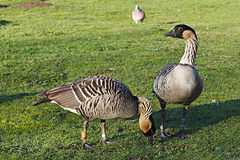WWT Slimbridge
| WWT Slimbridge | |
|---|---|

Slimbridge has numerous nene (also known as Hawaiian geese), the rarest goose in the world.
|
|
| WWT Slimbridge shown within Gloucestershire | |
| OS grid | SO720048 |
| Coordinates | 51°44′29″N 2°24′22″W / 51.741471°N 2.405979°WCoordinates: 51°44′29″N 2°24′22″W / 51.741471°N 2.405979°W |
| Area | 120 acres (49 ha) |
| Operated by | WWT |
| Status | Open |
| Website | www |
WWT Slimbridge is a wetland wildlife reserve near Slimbridge in Gloucestershire, England. It is midway between Bristol and Gloucester on the eastern side of the estuary of the River Severn. The reserve, set up by the artist and naturalist Sir Peter Scott, opened in November 1946. Scott subsequently founded the Wildfowl & Wetlands Trust, which has since opened eight reserves around the country. Slimbridge comprises some 800 hectares (2,000 acres) of pasture, reed bed, lagoon and salt marsh. Many water birds live there all year round, and others are migrants on their ways to and from their summer breeding grounds. Other birds overwinter, including large numbers of white-fronted geese and increasing numbers of Bewick's swans.
Besides having the world's largest collection of captive wildfowl, Slimbridge takes part in research and is involved in projects and internationally run captive breeding programmes. It was there that Peter Scott developed a method of recognising individual birds through their characteristics, after realising that the coloured patterns on the beaks of Bewick's swans were unique. The public can visit the reserve throughout the year. Besides examining the collections, they can view birds from hides and observatories and take part in educational activities.
The Wildlife and Wetland Trust at Slimbridge was set up by Peter Scott and opened on 10 November 1946, as a centre for research and conservation. In a move unusual at the time, he opened the site to the public so that everyone could enjoy access to nature.
...
Wikipedia

